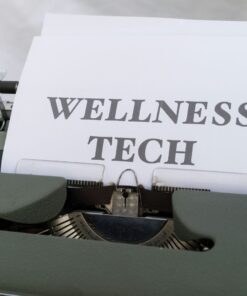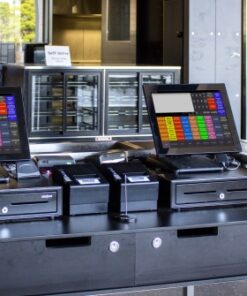Types of Receipt Printers
There are three main types of receipt printers commonly used in businesses today: thermal printers, dot matrix printers, and inkjet printers.
1. Thermal Printers
Thermal printers are widely regarded as the most popular type of receipt printer due to their speed, efficiency, and low maintenance requirements. These printers use heat to transfer ink onto the paper, eliminating the need for ink cartridges or ribbons. Thermal printers are known for their high-quality printing, producing clear and crisp receipts that are easy to read. They are also quite compact, making them ideal for businesses with limited counter space.
2. Dot Matrix Printers
Dot matrix printers, although less common than thermal printers, are still used in some industries that require multipart forms or carbon copies. These printers work by striking a ribbon against the paper, creating dots that form characters and images. Dot matrix printers are known for their durability and ability to print on a variety of paper types, including multipart forms. However, they are slower and noisier compared to thermal printers, which can be a drawback in busy environments.
3. Inkjet Printers
Inkjet printers, commonly used for printing documents and photos, can also be used as receipt printers. These printers work by spraying tiny droplets of ink onto the paper to create text and images. Inkjet printers offer the advantage of producing high-quality color prints, making them suitable for businesses that require receipts with logos or promotional materials. However, they are generally slower than thermal printers and may require more frequent maintenance, including ink cartridge replacements.
Key Characteristics of Receipt Printers
When choosing a receipt printer for your business, there are several key characteristics to consider:
1. Printing Speed
The printing speed of a receipt printer determines how quickly it can generate receipts. This is particularly important in busy environments where customers expect fast service. Thermal printers are known for their fast printing speed, making them ideal for businesses with high transaction volumes.
2. Connectivity Options
Receipt printers can be connected to a point-of-sale (POS) system or a computer via various connectivity options, including USB, Ethernet, Bluetooth, and Wi-Fi. The choice of connectivity depends on your business setup and requirements.
3. Paper Width
The paper width supported by a receipt printer determines the size of receipts it can print. Most receipt printers support standard paper widths of 2.25 inches or 3 inches. However, there are also printers available that can handle wider paper sizes for specialized applications.
4. Durability
Receipt printers are subjected to constant use and can be exposed to harsh environments. Therefore, it is important to choose a printer that is durable and can withstand the demands of your business. Thermal printers are generally more durable than dot matrix or inkjet printers.
5. Cost
The cost of a receipt printer is an important consideration for any business. Thermal printers are often more expensive upfront but tend to have lower ongoing costs due to the absence of ink cartridges or ribbons. Dot matrix printers are generally more affordable but may require more frequent maintenance and consumable replacements.
By considering these key characteristics, you can select a receipt printer that best suits the needs of your business. Whether you choose a thermal printer for its speed and efficiency, a dot matrix printer for its versatility, or an inkjet printer for its color capabilities, having a reliable receipt printer is essential for providing professional and accurate receipts to your customers.
1. Thermal Receipt Printers
Thermal receipt printers are one of the most popular types of receipt printers used in the industry. These printers use heat to create an image on heat-sensitive thermal paper, eliminating the need for ink cartridges or ribbons. This makes them cost-effective and low-maintenance devices. Thermal printers offer high-speed printing, producing clear and legible receipts in a matter of seconds. They are known for their reliability and durability, making them suitable for high-volume printing environments.
Thermal receipt printers are available in two main variants: direct thermal and thermal transfer. Direct thermal printers use heat directly on the thermal paper to create the image, while thermal transfer printers use a ribbon to transfer ink onto the paper. Direct thermal printers are more commonly used due to their simplicity and cost-effectiveness.
Direct thermal printers work by applying heat to the thermal paper, causing a chemical reaction that produces the desired image. The paper contains a layer of heat-sensitive chemicals that react when exposed to heat, turning black and creating the image. This process is quick and efficient, resulting in fast and reliable printing.
One of the advantages of direct thermal printers is their simplicity. Since they do not require ink cartridges or ribbons, there are fewer components that can malfunction or require replacement. This makes them easier to maintain and reduces the overall cost of ownership. Additionally, the absence of ink or toner cartridges eliminates the need for messy refills or replacements, saving time and effort.
Another advantage of direct thermal printers is their cost-effectiveness. Without the need for ink or toner, the ongoing operating costs are significantly lower compared to other types of printers. This makes them an attractive option for businesses that require frequent receipt printing, such as retail stores, restaurants, and hospitality establishments.
In terms of print quality, direct thermal printers produce clear and legible receipts. The heat-sensitive chemicals on the thermal paper react precisely to create sharp images and text. The resulting prints are resistant to fading and smudging, ensuring that the information on the receipts remains intact over time. This is especially important for businesses that need to keep accurate records for accounting and auditing purposes.
Overall, direct thermal printers offer a reliable and cost-effective solution for receipt printing. Their simplicity, low maintenance requirements, and high-quality output make them a popular choice in various industries. Whether it’s a small retail store or a large-scale restaurant, direct thermal printers can meet the demands of any business that requires fast and efficient receipt printing.
Dot matrix receipt printers have been a staple in the printing industry for many years. Their unique printing mechanism sets them apart from other types of printers. Instead of using a traditional print head that moves across the paper, dot matrix printers utilize a print head that strikes an inked ribbon against the paper to create the desired text or image. This impact printing method allows for precise and reliable printing, making dot matrix printers a popular choice for businesses that require accurate and detailed receipts. One of the key advantages of dot matrix printers is their ability to print multiple copies of receipts simultaneously. This feature is particularly useful for businesses that need duplicate or triplicate copies for record-keeping purposes. The impact printing mechanism allows the print head to strike the inked ribbon against the paper with enough force to create clear and legible copies, ensuring that all copies are identical. Another advantage of dot matrix printers is their durability. These printers are designed to withstand harsh environments and heavy usage, making them ideal for businesses that require a reliable and long-lasting printing solution. Dot matrix printers can handle various types of paper, including multipart forms, which adds to their versatility. This feature is particularly beneficial for businesses that need to print receipts on different types of paper, such as carbonless forms or pre-printed stationery. However, it is important to note that dot matrix printers are generally slower compared to thermal printers. The impact printing process takes more time as the print head strikes the inked ribbon against the paper, resulting in a slower printing speed. Additionally, dot matrix printers tend to produce lower-quality prints compared to thermal printers. The impact of the print head can sometimes cause slight distortions or smudges, which may affect the overall print quality. In conclusion, dot matrix receipt printers offer a reliable and durable printing solution for businesses that require accurate and detailed receipts. Their ability to print multiple copies simultaneously and handle various types of paper makes them versatile and practical. Despite their slower printing speed and lower print quality, dot matrix printers remain a popular choice for businesses in need of a reliable and long-lasting printing solution.
Inkjet receipt printers are a relatively newer type of receipt printer that uses inkjet technology to create prints. These printers work by spraying tiny droplets of ink onto the paper to form the desired text or image. Inkjet printers are known for their ability to produce high-quality prints with vibrant colors and sharp details.
Inkjet receipt printers are suitable for businesses that require receipts with complex graphics or logos. They offer flexibility in terms of printing on different types of paper, including glossy or photo paper. However, inkjet printers can be slower compared to thermal printers and may require more frequent ink cartridge replacements, making them more suitable for businesses with lower printing volumes.
One of the advantages of inkjet receipt printers is their ability to produce prints with a wide color gamut. This means that they can accurately reproduce a broader range of colors, resulting in vibrant and eye-catching receipts. This can be particularly beneficial for businesses in industries such as fashion, beauty, or art, where aesthetics play a crucial role in attracting customers.
Moreover, inkjet receipt printers allow businesses to print receipts with complex graphics or logos. This is especially advantageous for companies that want to brand their receipts and create a consistent visual identity across all customer touchpoints. By incorporating their logo or other visual elements into the receipt design, businesses can reinforce their brand image and enhance customer recognition.
In addition to their versatility in printing on different types of paper, inkjet receipt printers also offer the option to print on larger paper sizes. While thermal printers are typically limited to standard receipt sizes, inkjet printers can accommodate larger paper formats. This can be useful for businesses that need to print detailed invoices or receipts with additional information, such as terms and conditions or promotional offers.
However, it’s important to note that inkjet printers may have higher operational costs compared to thermal printers. The frequent replacement of ink cartridges can add up over time, especially for businesses with high printing volumes. Additionally, the printing speed of inkjet printers is generally slower than thermal printers, which may not be ideal for businesses that require fast and efficient printing.
Overall, inkjet receipt printers are a suitable option for businesses that prioritize print quality and the ability to print on different paper types. Their ability to produce vibrant colors and accommodate complex graphics or logos makes them an excellent choice for businesses in industries where aesthetics and branding are essential. However, businesses with high printing volumes may need to consider the operational costs and printing speed associated with inkjet printers before making a decision.
4. Mobile Receipt Printers
Mobile receipt printers are compact and portable devices that allow businesses to print receipts on the go. These printers are designed to connect wirelessly to mobile devices such as smartphones or tablets, enabling businesses to provide receipts to customers wherever they are.
Mobile receipt printers are commonly used in industries such as delivery services, transportation, and outdoor events where mobility is essential. They offer convenience and flexibility, allowing businesses to streamline their operations and enhance customer service. Mobile receipt printers are available in various connectivity options, including Bluetooth and Wi-Fi, ensuring compatibility with different mobile devices.
One of the key advantages of mobile receipt printers is their portability. These devices are lightweight and compact, making them easy to carry around. Whether a delivery driver needs to provide a receipt for a package or a food vendor wants to offer a printed receipt to a customer at an outdoor event, mobile receipt printers can be conveniently brought along and used on the spot.
Moreover, mobile receipt printers are designed to withstand the rigors of a mobile business environment. They are built to be durable and resistant to dust, moisture, and other environmental factors. This ensures that they can withstand the demands of various industries, including those that involve frequent movement and exposure to different weather conditions.
In addition to their portability and durability, mobile receipt printers offer seamless connectivity with mobile devices. They can easily connect to smartphones or tablets via Bluetooth or Wi-Fi, eliminating the need for cumbersome cables or wires. This wireless connection enables businesses to quickly print receipts without any hassle, saving time and improving efficiency.
Furthermore, mobile receipt printers come with user-friendly features that enhance the overall user experience. They often have intuitive interfaces and easy-to-use buttons, allowing even non-technical users to operate them effortlessly. Some models also offer advanced features such as automatic paper cutting and barcode scanning, further streamlining the receipt printing process.
Overall, mobile receipt printers are invaluable tools for businesses that require on-the-go receipt printing. With their portability, durability, wireless connectivity, and user-friendly features, these devices enable businesses to provide efficient and convenient service to their customers, no matter where they are.




